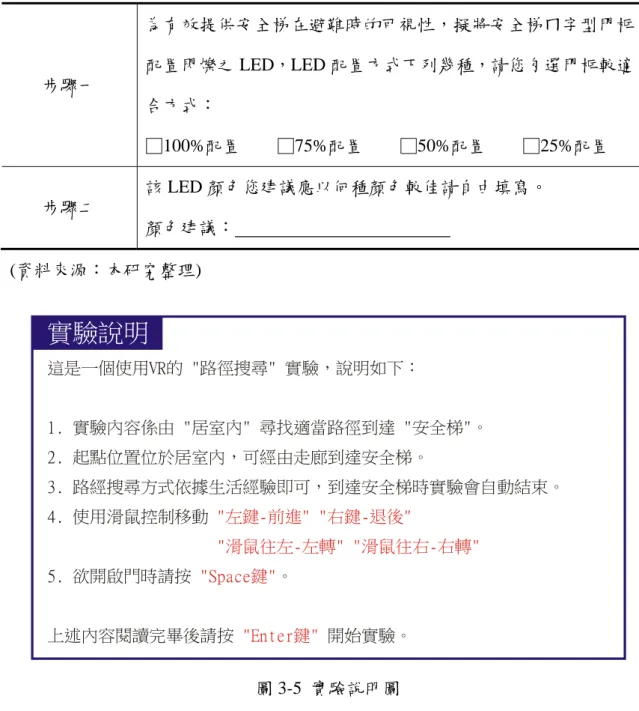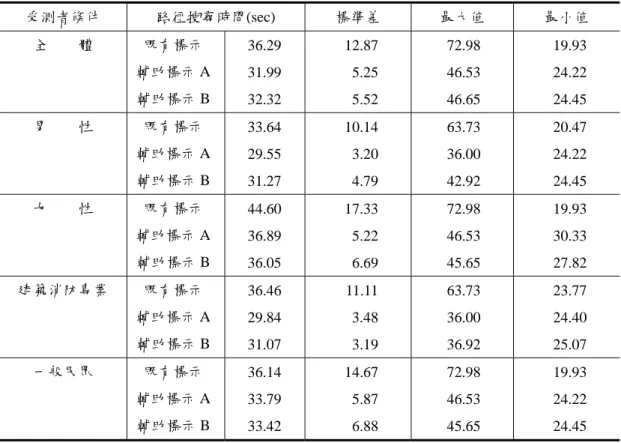避難標示輔助設備之應用研究
全文
(2)
(3) 避難標示輔助設備之應用研究. 內政部建築研究所委託研究報告 中華民國 98 年 12 月.
(4)
(5) PG9802-0205 098301070000G1017. 避難標示輔助設備之應用研究. 受 委 託 者:國立台灣科技大學 研究主持人:湯潔新 協同主持人:林慶元 研 究 員:莊英吉 研 究 助 理:張賀婷. 內政部建築研究所委託研究報告 中華民國 98 年 12 月.
(6)
(7) 目. 次. 避難標示輔助設備之應用研究. 目. 次. 目. 次 ····················································································· Ⅰ. 表. 次 ····················································································· Ⅲ. 圖. 次 ····················································································· Ⅳ. 摘. 要 ····················································································· Ⅶ. 第一章. 緒. 論 ········································································· 1. 第一節. 研究緣起與背景··························································· 1. 第二節. 研究範圍與內容··························································· 4. 第三節. 研究方法及流程··························································· 6. 第四節. 蒐集資料與文獻分析····················································· 10. 第五節. 研究成果 ··································································· 16. 第二章. 理論架構建立 ··································································· 17. 第一節. 避難標示相關法令之探討 ··············································· 17. 第二節. 標示與方位認知··························································· 20. 第三節. 避難行為 ··································································· 24. 第四節. 虛擬實境與避難··························································· 28. 第三章. 虛擬實境實驗方法······························································ 33. 第一節. 實驗模擬空間概述························································ 33. 第二節. 實驗設備與模擬環境設定 ··············································· 33 I.
(8) 避難標示輔助設備之應用研究 . 第三節. 實驗程式與設計··························································· 35. 第四節. 參與實驗人員······························································ 43. 第五節. 分析方法 ··································································· 45. 第四章. 第一節. 路徑搜尋所需時間························································ 47. 第二節. 影響路徑搜尋差異因素·················································· 53. 第三節. 不同變數對路徑搜尋之相關性分析 ··································· 54. 第四節. 實驗結果與既有文獻之比對 ············································ 59. 第五章. 全尺寸實驗計畫································································· 61. 第一節. 全尺寸實驗空間概述····················································· 61. 第二節. 實驗空間情境與環境限制 ··············································· 62. 第三節. 實驗程序 ··································································· 65. 第四節. 實驗分析項目······························································ 67. 第五節. 實驗記錄內容······························································ 68. 第六節. 實驗設備及工作人員編制 ··············································· 69. 第七節. 參與實驗人員(樣本)······················································ 71. 第六章. II. 虛擬實境模擬結果與分析····················································· 47. 全尺寸實驗結果與分析························································ 73. 第一節. 路徑搜尋所需時間························································ 73. 第二節. 影響路徑搜尋差異因素·················································· 76. 第三節. 全尺寸與虛擬實境比對分析 ············································ 78. 第四節. 主觀評價分析結果························································ 80.
(9) 目. 第七章. 次. 結論與建議 ······································································ 91. 第一節. 結. 論 ······································································ 91. 第二節. 建. 議 ······································································ 94. 第三節. 未來研究建議······························································ 96. 附錄一. 期初簡報意見與回應··························································· 97. 附錄二. 工作會議紀錄 ··································································· 101. 附錄三. 期中簡報意見與回應··························································· 109. 附錄四. 第一次專家學者座談會議紀錄 ··············································· 119. 附錄五. 第二次專家學者座談會議紀錄 ··············································· 123. 附錄六. 期末簡報意見與回應··························································· 127. 附錄七. 納入「出口標示燈及避難方向指示燈認可基準」建議條文 ··········· 133. 附錄八. 本研究部份成果投稿 Journal of Applied Fire Science (EI)接受全文··· 137. 參考書目 ····················································································· 153. III.
(10) 避難標示輔助設備之應用研究 . IV.
(11) 表. 表. 次. 次. 表 1-1 避難行為文獻 ······································································ 10 表 1-2 避難實驗文獻 ······································································ 11 表 1-2 避難安全評估文獻 ································································ 13 表 2-1 認可基準引導燈具規定 ·························································· 19 表 3-1 VR 模擬情境說明 ·································································· 35 表 3-2 輔助標示圖像建構專家問卷 ···················································· 37 表 3-3 受測者實驗紀錄表 ································································ 44 表 3-4 九種情境樣本屬性表 ····························································· 44 表 4-1 既有標示路徑搜尋時間 ·························································· 47 表 4-2 輔助標示 TYPE A 路徑搜尋時間 ··············································· 48 表 4-3 輔助標示 TYPE B 路徑搜尋時間 ··············································· 48 表 4-4 相同路徑 L1 不同標示的比較 ·················································· 50 表 4-5 相同路徑 L2 不同標示的比較 ·················································· 50 表 4-6 相同路徑 L3 不同標示的比較 ·················································· 51 表 4-7 性別對不同標示的檢定 ·························································· 53 表 4-8 專業別對不同標示的檢定 ······················································· 53 表 4-9 不同路徑各變數與路徑搜尋時間相關性(既有標示) ······················· 54 表 4-10 不同路徑節點選擇特性(既有標示) ··········································· 55 表 4-11 不同路徑樓梯選擇特性(既有標示) ··········································· 55 表 4-12 不同路徑各變數與路徑搜尋時間相關性(TYPE A) ························ 56 表 4-13 不同路徑節點選擇特性(TYPE A) ············································· 57 表 4-14 不同路徑樓梯選擇特性(TYPE A) ············································· 57 表 4-15 不同路徑各變數與路徑搜尋時間相關性(TYPE B) ························ 58 表 4-16 不同路徑節點選擇特性(TYPE B) ············································· 58. V.
(12) 避難標示輔助設備之應用研究 . 表 4-17 不同路徑樓梯選擇特性(TYPE B) ············································· 59 表 4-18 尋路特徵與文獻比較 ···························································· 60 表 5-1 實驗設備表 ········································································· 69 表 5-2 工作人員編制 ······································································ 69 表 6-1 輔助標示路徑搜尋時間-無煙霧 ················································ 73 表 6-2 輔助標示路徑搜尋時間-有煙霧 ················································ 74 表 6-3 平均步行速度-無煙霧 ···························································· 74 表 6-4 平均步行速度-有煙霧 ···························································· 74 表 6-5 無煙霧下的檢定 ··································································· 76 表 6-6 有煙霧下的檢定 ··································································· 76 表 6-7 不同情境節點選擇特性 ·························································· 77 表 6-8 不同情境樓梯選擇特性 ·························································· 77 表 6-9 無煙霧下的全尺寸與虛擬實境檢定 ··········································· 78 表 6-10 全尺寸與虛擬實境節點選擇特性比較 ······································· 79 表 6-11 全尺寸與虛擬實境樓梯選擇特性比較 ······································· 79 表 6-12 無煙霧主觀評估結果表 ························································· 84 表 6-13 無煙霧主觀評估檢定 ···························································· 84 表 6-14 有煙霧主觀評估結果表 ························································· 88 表 6-15 有煙霧主觀評估檢定 ···························································· 89. VI.
(13) 圖. 圖. 次 . 次. 圖 1-1 實驗流程圖 ········································································· 7 圖 1-2 研究流程圖 ········································································· 9 圖 2-1. CNS 10207 之圖形規定 ························································· 18. 圖 2-2. 出口標示燈 ········································································ 18. 圖 2-3. 避難方向指示燈 ·································································· 18. 圖 3-1 模擬空間平面圖 ··································································· 33 圖 3-2 照度計 SEKONIC L-508 ························································· 34 圖 3-3 模擬情境工作站安排 ····························································· 34 圖 3-4 模擬情境路線圖 ··································································· 35 圖 3-5 實驗說明圖 ········································································· 37 圖 3-6 模擬結點(起點) ···································································· 38 圖 3-7 模擬結點(走廊) ···································································· 38 圖 3-8 模擬結點(電梯間) ································································· 39 圖 3-9 模擬結點(安全梯) ································································· 39 圖 3-10 模擬結點(安全梯)線狀 ·························································· 40 圖 3-11 模擬結點(安全梯)點狀 ·························································· 40 圖 3-12 模擬程式執行流程圖 ···························································· 41 圖 5-1 全尺寸實驗範圍示意圖 ·························································· 61 圖 5-2 輔助標示安裝完工圖-中央安全梯未啟動 ···································· 63 圖 5-3 輔助標示安裝完工圖-中央安全梯已啟動 ···································· 63 圖 5-4 輔助標示安裝完工圖-側邊安全梯未啟動 ···································· 64 圖 5-5 輔助標示安裝完工圖-側邊安全梯已啟動 ···································· 64 圖 5-6 施放煙霧情境-走廊未啟動 ······················································ 65 圖 5-7 施放煙霧情境-走廊已啟動 ······················································ 65. VII.
(14) 避難標示輔助設備之應用研究 . 圖 5-8 LED 近照-未啟動 ·································································· 70 圖 5-9 LED 近照-已啟動 ·································································· 70 圖 6-1 無煙霧可視性主觀評價統計圖 ················································· 80 圖 6-2 無煙霧彩度性主觀評價統計圖 ················································· 81 圖 6-3 無煙霧明亮度主觀評價統計圖 ················································· 81 圖 6-4 無煙霧意義性主觀評價統計圖 ················································· 82 圖 6-5 無煙霧整體性主觀評價統計圖 ················································· 82 圖 6-6 無煙霧避難引導主觀評價統計圖 ·············································· 83 圖 6-7 有煙霧可視性主觀評價統計圖 ················································· 85 圖 6-8 有煙霧彩度性主觀評價統計圖 ················································· 86 圖 6-9 有煙霧明亮度主觀評價統計圖 ················································· 86 圖 6-10 有煙霧意義性主觀評價統計圖 ················································ 87 圖 6-11 有煙霧整體性主觀評價統計圖 ················································ 87 圖 6-12 有煙霧避難引導主觀評價統計圖 ············································· 88. VIII.
(15) 摘. 摘. 要. 要. 關鍵詞:避難標示、路徑搜尋、圖像認知、虛擬實境. 一、研究緣起 避難所需時間一直是能否達成安全避難的首要指標,避難時間的長短亦是造 成人員傷亡多寡的重要關鍵,對於標示設備與空間環境所造成的避難行動影響亦 不容忽視。目前建築物中的避難計畫,主要依據各類場所消防安全設備設置標準 來設置相關避難標示,該標示在避難過程中所提供路徑搜尋的協助效能並不明 確,因此透過既有標示的改善來提高避難上的協助亦值得加以探討,適當改善既 有標示或建立輔助性標示亦屬當務之急。此外,出口標示燈設於出入口上方(第 146-3 條),然建築火災的黑煙會由天花板開始向下蓄積,火災的黑煙有影響出口標 示燈正常功能之虞,適度的調整及改善目前既有標示型態應有其必要性。. 二、研究方法及過程 受限於火災時之避難行為無法於真實環境下進行實驗,因此將採用虛擬實境 (Virtual Reality)方式來進行模擬,透過使用者閱讀標示後的空間移動來解析標示對 路徑搜尋的影響。模擬時將採單人一人一機方式進行,且圖面閱讀與空間理解僅 涉及個別使用者的分析,故暫不考慮多人同時模擬。 具體研究方法有二:1. 虛擬實境模擬、2. 全尺寸實驗。其中虛擬實境部分又 可分為三種:目前標示/目前標示+輔助標示 TYPE A(點狀)/目前標示+輔助標 示 TYPE B(線狀)。全尺寸模擬則以前述最佳輔助標示進行實驗並加入煙霧的模擬。. IX.
(16) 避難標示輔助設備之應用研究 . 三、重要發現 本研究綜合前述研究方法,在一年以內完成虛擬實境與全尺寸實驗並達成主 要研究成果與發現,其簡要說明如下: 1. 依據不同背景分析得知,路徑搜尋所需時間:女性>一般民眾>專業者≒男性。 若依不同標示區分時,路徑搜尋所需時間:既有標示>輔助標示 B>輔助標示 A。 2. 性別造成路徑搜尋有所差異但並非每種情境均是如此,是否與空間規模大小有 關則有待證實。 3. 居室到走廊每通過一次出入口(門),須增加 3~5 秒避難時間。在不熟悉空間中, 居室內開門形式雖然符合使用概念但卻不利逃生。 4. 在可自由選擇左右轉時,門的可視性將成為決定關鍵因子,且將造成不同於習 慣左轉慣例。由節點選擇與樓梯選擇證實,輔助標示效能顯著,所有受測者均 未產生回頭或猶豫情境。 5. 全尺寸實驗發現專業人員看見煙霧時大多仍會依據職業習慣加速。在有煙霧情 境下除了專業者外其餘樣本路徑搜尋所需時間均較無煙霧情境略為增加,時間 增加主要來自於由居室(無煙)進入到走廊(有煙)時,不少受測者會停頓 2~3 秒所 造成。 6. 無煙與有煙情境檢定結果發現未達顯著水準,證實本研究所提供的輔助標示則 提供良好避難引導,即使在有煙情境時也是如此。 7. 證實一般性實驗以虛擬實境取代真實實驗屬於可行的方式,但特定情況則須有 明確的前提條件。當受測樣本為一般民眾且符合常態分配時,此類研究虛擬實 驗可以取代真實實驗。. 四、主要建議事項 立即可行建議 主辦機關:各縣市政府 協辦機關:各縣市政府消防局、建管單位 X.
(17) 摘. 要. 部分民眾對於既有標示認知仍不熟悉,在輔助標示尚未建立前應加強教育宣 導工作,其對象應以公共場所為主。. 中長期建議 主辦機關:內政部消防署、營建署 協辦機關:各縣市政府 輔助標示(TYPE A)對於路徑搜尋協助效能最佳,且與既有標示間存有明顯差 異,因此建議應儘速擬定輔助標示設備專章,透過立法程序納入現有法令中,以 確保民眾避難安全。其執行策略初步建議可從兩方面思考,一是進行性能設計時, 排除若干法條(例如:最大步行距離)應強制要求須設置輔助標示,增加避難安全 性。二是選擇特定場所施行(例如:商場、車站),此特定場所為一定規模以上、不 熟悉環境、人潮眾多等。. XI.
(18) 避難標示輔助設備之應用研究 . XII.
(19) 摘. 要. Abstract Keywords: emergency signs, way-finding, image recognition, virtual reality. I.. Introduction The required time for emergency escape is the first indicator of safe evacuation,. and the length of time is also a key to determine the number of casualties. The impacts of signs and spatial environment should not be overlooked. Presently, relative evacuation signs of buildings are set according to the Standard for the Installation of Fire Safety Equipment. However, emergency signs can not be clearly observed for way-finding during emergencies and thus, there is a need to improve existing emergency signs in order to assist in safe evacuation. Proper improvement of signs and installment of supplementary signs are the top priority. In addition, the emergency exit lights are often installed on the top of exits (Article 146-3), but during a fire, smoke will move down from the ceiling and obscure the exit signs. Therefore, proper adjustment and improvement of existing signs are necessary.. II.. Methods Since emergency escape behaviors during a fire can not be experimented in real. environment, virtual reality technology is adopted to conduct simulation. Through user’s moving process after reading signs, how signs influence way-finding can be analyzed. The simulation is conducted individually (one-man-one-machine). Sign reading and spatial perceiving only involve single user instead of multi-users. Thus, simultaneous multi-user-simulation will not be adopted at this stage. There are two methods of this study: (1) virtual reality simulation; (2) full-scale XIII.
(20) 避難標示輔助設備之應用研究 . experiment. VR simulation experiment comprise three types: existing sign/ existing sign + supplementary sign Type A (dotted)/existing sign + supplementary sign Type B (lined). Full-scale simulation is conducted based on the best supplementary sign, and smoke simulation will be also adopted as well.. III. Results This study accomplished virtual reality simulation and full-scale experiment by aforesaid methods within one year. A few results are found as follows: 1. Analyzed based on the background of participants, the sequence of required time for way-finding is: Female > Non-professional > Professional ≒ Male. Given a different sign condition, way-finding time in length sequence is: existing sign > supplementary sign B > supplementary sign A. 2. There is indeed a difference of way-finding time between male and female, but not all conditions have gender differences. Whether it is related to spatial scale requires further verification. 3. 3~5 seconds will be required for every time a user passes an entrance (door) from the room to the hallway. If the user is not familiar with the environment, doors will delay the emergency escape even if they conform to basic design concepts. 4. Door visibility will become the key factor for user to determine the direction of turn (right/left), and users tend to turn left. Node selection and staircase selection have proved the significance of supplementary signs. All participants did not hesitate and did not go back after making a selection. 5. In the full-scale experiment, it is found that professionals did accelerate when they saw smoke, due to occupational habits. Except for the professionals, participants seemed to require more time for way-finding in smoke environment than non-smoke environment, since many participants paused 2~3 seconds when they entered XIV.
(21) 摘. 要. hallways (smoke environment) from rooms (non-smoke environment). 6. The test result of smoke/non-smoke scenario didn’t reach significant level, which shows that the supplementary signs in this study have provided a good guidance for emergency escape, even in the smoke scenario. 7. It has proved that on-site experiment can be replaced by virtual reality simulation in general experiments, if the precondition is clear, or, the participants come from general public and conform to normal distribution.. IV. Suggestions Short-term Suggestions Main-responsible Sector : Local Governments Minor- responsible Sectors : Local Fire Department and Architecture Department Some of the public are still unfamiliar with existing signs. Education and promotion on such issues should be improved before supplementary signs are installed, especially at public places.. Medium & Long-term Suggestions Main-responsible Sector : National Fire Agency, Ministry of The Innterior and Construction and Planning Agency, Ministry of the interior Minor- responsible Sectors : Local Governments Supplementary signs (TYPE A) provide the most effective assistance for way-finding, and it has a significant difference from existing signs. Regulations regarding installment of supplementary signs should be stipulated through legislative procedure as soon as possible, so as to ensure pubic safety of evacuation. There are two feasible ways at initial stage: (1) In order to optimize safety of evacuation, supplementary signs should be installed during performance design, even if some XV.
(22) 避難標示輔助設備之應用研究 . regulations will have to be disregarded (ex. maximum walking distance); (2) Such regulations should be implemented in specific places, especially those which have large scale, unfamiliar environment to the general public, and huge crowds (ex. malls or stations).. XVI.
(23) 第一章 緒. 第一章. 第一節. 緒. 論. 論. 研究緣起與背景. 壹、研究緣起 建築物防火與避難是建築安全中的首要課題,其中避難行為涉及人的因素, 因此向來較難進行量化研究,然而近來透過社會科學的方式已可對此類研究進行 探討。此外避難所需時間一直是能否達成安全避難的首要指標,避難時間的長短 亦是造成人員傷亡多寡的重要關鍵,在建築物防火避難安全性能驗證中對於避難 所需時間亦有明確的規範與計算方式,但在火場中人群避難的行為除了與人因工 學有密切相關外,對於標示設備與空間環境所造成的避難行動影響亦不容忽視。 目前建築物中的避難計畫,主要依據各類場所消防安全設備設置標準來設置相關 避難標示,該標示在避難過程中所提供路徑搜尋的協助效能並不明確,因此有必 要透過適當的學理方式來加以驗證,以確保該標示在避難時的功能。然而透過既 有標示的改善來提高避難上的協助亦值得加以探討,因此適當改善既有標示或建 立輔助性標示亦屬當務之急。 有關避難標示的認知,經由九十四年度的研究證實,性別與年齡均未明顯影 響標示閱讀,但對於標示設備所攜帶之意義則有頃向無法理解之現象。另於九十 五年度的研究透過虛擬實境技術提出避難標示(CNS 10207)修正提案,並建立本土 性避難時間基礎資料以及避難行為模式的初探。在國外有關標示認知方面的研 究,Piamonte (2001)[1]發現藉由標示認知的等級測驗結果將有助於標示的設計與改 進,Murray (1998)[2]則發現不同圓形的禁止符號將產生不同的偏好等級,因此符 號的表示方式將會影響認知的結果,Wogalter (2002)[3]與 Shieh (2003)[4]則針對警 告性符號進行研究,透過圖形的設計、安排,以提升使用者對警告性圖示的瞭解。 而 Petiot (2004)[5]亦使用語義分析法來解析符號意義傳遞與認知的關係。由此可 1.
數據

![表 1-3 避難安全評估文獻 作 者 文 獻 名 稱 主 要 大 鋼 與 結 論 陳重傑[20] 高層辦公建築火災避難安 全評估之研究 藉由國內外避難演練文獻蒐集與配合國內相關法規,實際進行全尺寸避難演練,將實 際演練之各項避難時間與日本避難安全檢 證法、英國 building-EXODUS 等避難安全評 估模式進行比較分析。 鄭琮琰[21] 大型空間展覽場展覽活動 之避難安全評估之研究 展覽物間隔過密、臨設展示隔間阻斷動線、安全標示之指引方向不明、裝修物遮蔽緊急](https://thumb-ap.123doks.com/thumbv2/9libinfo/8905859.259096/35.892.134.761.134.1164/陳重傑寸避練將際演練之各項避難時間與日本避難鄭琮琰研究展覽.webp)


相關文件
From the findings reported above, it is undeniable that there has been huge progress in ITEd in Hong Kong schools, as reflected by the significantly improved infrastructure, the
All participants should be made aware of the potential hazards of the field and the necessary safety precautions during briefings on the fieldwork or upon arrival at the site.
If w e sell you land, you m ust rem em ber that it is sacred, and you m ust teach your children that it is sacred and that each ghostly reflection in the clear w ater of the lakes
If general metaphysics insists on positing something ‘infinite’, qualitatively different from finite things, and takes it to be the only object worth pursuing, then such a view
The point should then be made that such a survey is inadequate to make general statements about the school (or even young people in Hong Kong) as the sample is not large enough
Dynamic programming is a method that in general solves optimization prob- lems that involve making a sequence of decisions by determining, for each decision, subproblems that can
* All rights reserved, Tei-Wei Kuo, National Taiwan University, 2005..
A system is said to be in stable equilibrium if, when displaced from equilibrium, it experiences a net force or torque in a direction opposite to the direction of the displacement..





